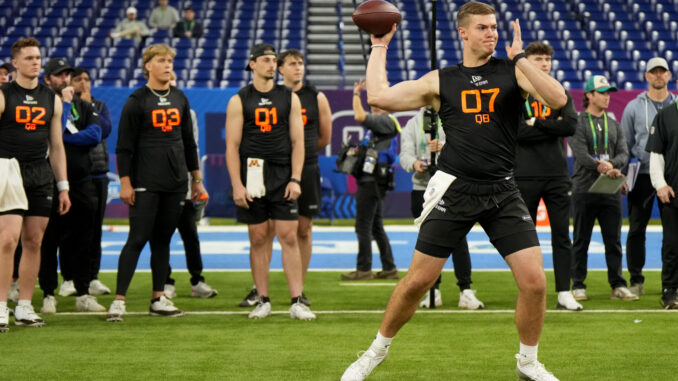
In the lead-up to the 2025 NFL Draft, the quarterback class has been a focal point of intense scrutiny and debate among analysts, scouts, and fans alike. One intriguing development has been the rise of two former Ohio State quarterbacks—Kyle McCord and C.J. Stroud—who have ascended to higher rankings than Will Howard, who transferred to Ohio State for his final collegiate season. This shift has sparked discussions about the factors influencing quarterback evaluations and the intricacies of the draft process.
C.J. Stroud: From Ohio State to NFL Stardom
C.J. Stroud’s journey from Ohio State to the NFL has been nothing short of remarkable. During his tenure with the Buckeyes, Stroud set multiple records, including the most passing yards in a single game (573) and the distinction of being the first player to throw for six touchdowns three times. His performance earned him Heisman Trophy finalist honors in both 2021 and 2022. These collegiate achievements paved the way for his selection by the Houston Texans as the second overall pick in the 2023 NFL Draft. In his rookie season, Stroud led the Texans to a division title and a playoff victory, culminating in the Offensive Rookie of the Year Award. citeturn0search24
Kyle McCord: A Stellar Season with Syracuse
Kyle McCord’s decision to transfer from Ohio State to Syracuse for his final collegiate year proved to be a pivotal move in his football career. Leading the Orange, McCord topped the nation with 4,779 passing yards and ranked fourth with 34 touchdowns against 12 interceptions in the 2024 season. His performance not only revitalized Syracuse’s offense but also garnered him a spot in Mel Kiper’s Top 10 quarterback rankings, where he entered at the fifth position. citeturn0search6
Will Howard: The Ohio State Transfer’s Impact
Will Howard’s transition to Ohio State was met with high expectations. Standing at 6-foot-4 and weighing 235 pounds, Howard possessed the physical attributes coveted in NFL quarterbacks. During the 2024 season, he led the Buckeyes to a national championship, contributing significantly with 42 total touchdowns, including seven rushing scores, and amassing 4,010 passing yards with a 73% completion rate. citeturn0search5 Despite these accomplishments, Howard’s draft stock experienced fluctuations. Mel Kiper’s rankings saw Howard rise to the fourth position following the national championship but later drop to the seventh spot, reflecting the dynamic nature of draft evaluations. citeturn0search1
Analytical Perspectives on Quarterback Evaluations
The varying draft positions of Howard, McCord, and Stroud underscore the complexities involved in evaluating quarterback talent. Factors such as collegiate performance, physical attributes, leadership qualities, and adaptability to different offensive systems play crucial roles in shaping analysts’ assessments. Moreover, the success of quarterbacks like Stroud in the NFL can influence perceptions of their collegiate performances, adding another layer to the evaluation process.
The Influence of Offensive Systems and Coaching
The offensive systems and coaching staffs that quarterbacks are exposed to during their collegiate careers can significantly impact their development and draft prospects. Stroud’s success at Ohio State, under the tutelage of head coach Ryan Day, provided him with a platform to showcase his talents on a national stage. Similarly, McCord’s decision to join Syracuse allowed him to lead a high-octane offense, resulting in impressive statistical outputs. Howard’s experience at Ohio State, culminating in a national championship, highlighted his ability to excel in a competitive environment. These experiences contribute to the multifaceted evaluations conducted by NFL teams.
Physical Attributes and Playing Style
Physical measurements and playing styles are scrutinized extensively during the draft process. Quarterbacks like Stroud and Howard, with their prototypical size and dual-threat capabilities, often attract favorable evaluations. Stroud’s poise under pressure and Howard’s physicality and leadership qualities add to their appeal. McCord’s agility and adaptability in leading Syracuse’s offense further enhance his draft profile, demonstrating that success can be achieved through diverse playing styles and systems.
The Role of Senior Seasons in Shaping Draft Stock
A quarterback’s senior season can be pivotal in influencing draft stock. McCord’s remarkable performance at Syracuse elevated his status among top quarterback prospects, showcasing his growth and readiness for the professional level. Howard’s leadership in securing a national championship with Ohio State highlighted his potential to perform in high-pressure situations, a trait valued by NFL teams. These late-career surges can significantly impact analysts’ rankings and teams’ evaluations.
Navigating the Complex Landscape of NFL Draft Evaluations
The trajectories of Will Howard, Kyle McCord, and C.J. Stroud exemplify the nuanced and multifaceted nature of NFL draft evaluations. While collegiate achievements provide a foundation, factors such as physical attributes, adaptability to offensive systems, and leadership qualities play integral roles in shaping draft prospects. As the 2025 NFL Draft approaches, the fluctuating rankings of these quarterbacks serve as a testament to the dynamic and often unpredictable process of talent assessment in professional football.
navlistRecent Developments in 2025 NFL Draft Quarterback Rankingsturn0news12,turn0news14,turn0news15

Leave a Reply